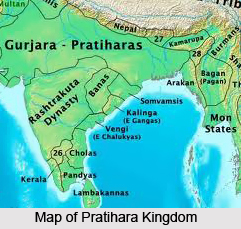 Origin of Pratihara Empire is a debatable issue due to which several theories have been put forward by the researchers. They themselves claim to have a supercilious origin. They assert themselves of the solar origin. The writing of the Pratiharas draws their origin to Lakshmana, Lord Rama`s brother who acted as Rama`s door-keeper or the Pratihara. When the Rashtrakuta king, Dantidurga, defeated the Gurjura king Nagabhata I, the latter was made a Pratihara (door-keeper) while Dantidurga performed the Hiranyagarbha dana ceremony at Ujjain.
Origin of Pratihara Empire is a debatable issue due to which several theories have been put forward by the researchers. They themselves claim to have a supercilious origin. They assert themselves of the solar origin. The writing of the Pratiharas draws their origin to Lakshmana, Lord Rama`s brother who acted as Rama`s door-keeper or the Pratihara. When the Rashtrakuta king, Dantidurga, defeated the Gurjura king Nagabhata I, the latter was made a Pratihara (door-keeper) while Dantidurga performed the Hiranyagarbha dana ceremony at Ujjain.
Many scholars viewed that Gurjara were foreigners who established their kingdoms in Punjab,Rajputana and Gujarat. Their settlement was confined to West of Aravali hills in Rajputana. But an intellectual has suggested that Gurjaras referred to a tribe concentrated in the region of Gujarat. Therefore they cannot be the foreign descendants. Hereafter no evidence is available of the foreign origin of the Pratiharas. The Pratiharas belonged to the same clan that of the Gurjaras was proved by the "Rajor inscription". From the phrase "Gurjara Pratiharanvayah" inscribed in the "Rajor inscription" it is known that the Pratiharas belonged to the Gurjara clan. The Rashtrakuta records and the Arabian chronicles also identify the Pratiharas with the Gurjaras.
Although this is not accepted by many and instead it is considered that they were Indians. Their ruling family belongs to Pratihara clan and empire created by them was called Gurjara Pratihara Empire. It was this dynasty which revived Kannauj`s glory as it was made the capital. In consonance with manuscripts of Prithviraj Rao it can be conferred that they one of the Agnikula clans of Rajputs deriving their origin from a sacrificial fire-pit at Mount Abu.
The Rajputs established their own superiority in northern India during the period between Harsha`s death and the Turkish invasion. Many dynasties belonging to the Rajput House rose to power. Pratiharas were the most incredible of all the Rajput clans.
However, the earliest Gurjara kingdom was founded by Harichandra in the middle of the 6th century in the Jodhpur of Rajputana. The dynasty founded by Harichandra came to be known as the Pratihara kingdom. Subsequently a branch of the Pratihara clan moved southward to Avanti. They founded a Pratihara kingdom in the region with their capital at Ujjaini. Thus, the Pratiharas laid their foundation in ancient India.
Their command was obeyed from Punjab to Central India and from Kathiawar to North Bengal. They had a major role to play in political amalgamation of India after Harsha Vardhana`s downfall.



















